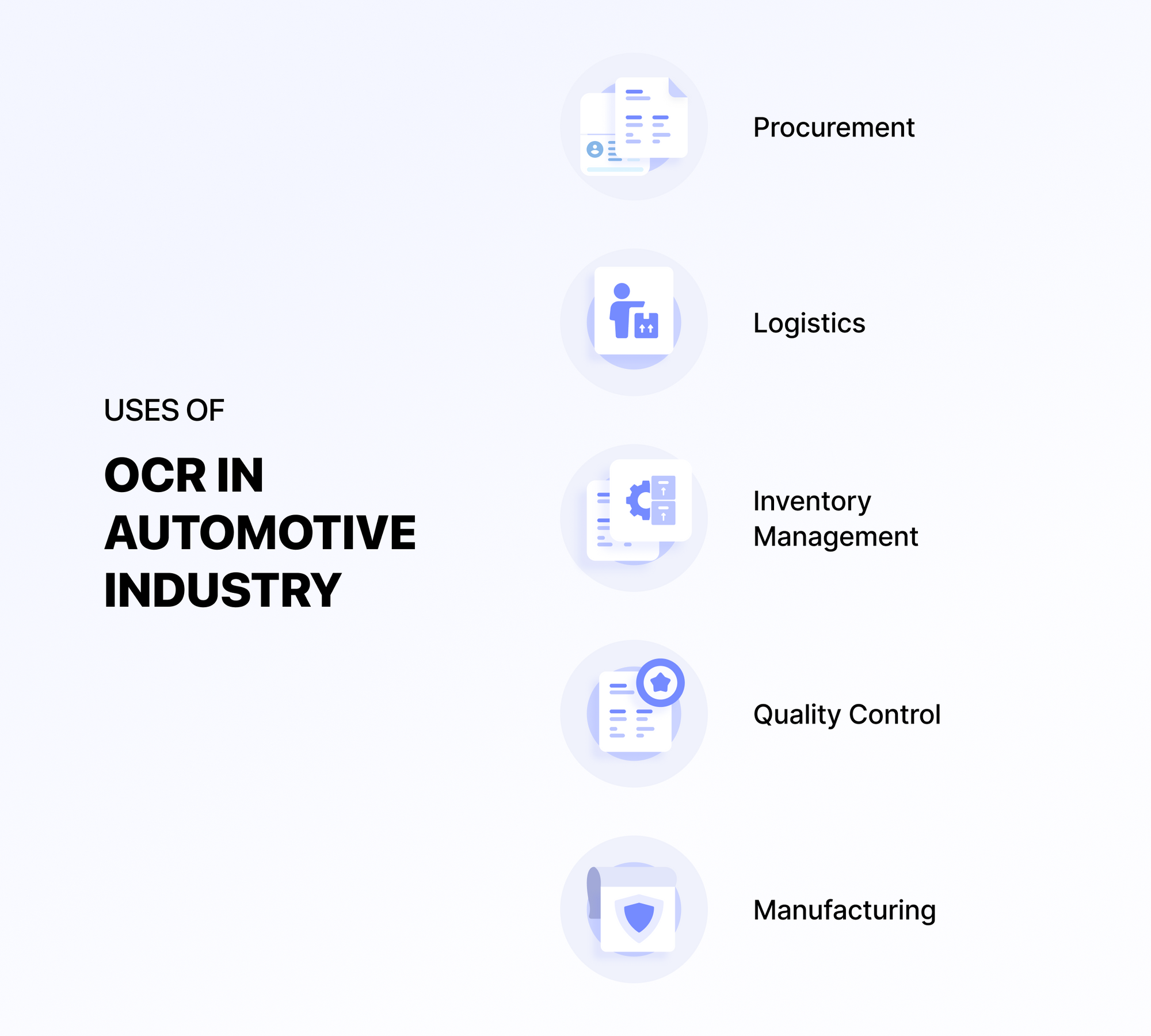
The automotive industry operates within a complex value chain that generates a significant volume of documents, data, and information. Optical Character Recognition (OCR) in the automotive industry is vital to establish an efficient flow of data and communication throughout the chain.
In addition to facilitating data management, effective document processing enables the integration of heterogeneous systems like ERP, WRM, SCM, and CRM, empowering informed decision-making and fostering business intelligence in this sector.
In light of these factors, digital document/data processing and management have become paramount. Not surprisingly, the automotive data management market was valued at USD 1.58 billion in 2021, propelled by technological advancements, including the introduction of AI-based applications, machine learning, big data, and the Internet of Things (IoT).
This article will look at the implications of digitization and automated document processing. We will focus on advanced Optical Character Recognition (OCR) tools within the automotive value chain.
Why is Document Processing Important in the Automotive Value Chain?
The efficient functioning of the automotive industry relies heavily on a diverse range of documents that serve crucial roles.
These documents encompass product specifications, engineering drawings, bills of materials, quality control records, supplier contracts, manufacturing instructions, compliance certifications, customer orders, and more.
In addition, accounting documents, such as purchase orders, invoices, inventory records, delivery notes, packing slips, airway bills, freight invoices, and bills of lading, must be meticulously processed at different stages throughout the value chain.
Documents and data are often scattered across departments, stakeholders, customers, and outsourcing partners and stored in various formats. Outsourcing and mergers may also complicate document management. As such, automotive sector stakeholders need help with document processing and management operations.
The efficient processing of documents ensures that relevant data is readily available to authorized personnel at any point in the value chain, fostering real-time decision-making, improved efficiency, and enhanced data visibility.
With efficient document processing techniques in place, all stakeholders in the sector can unlock the full potential of their data, optimize workflows, and drive innovation.
Efficient document processing enables supplier diversification, enhances supply chain visibility, manages costs, optimizes transportation, controls inventory, nurtures customer relationships, and facilitates collaborative data synchronization.
Automating Document Processing in the Automobile Value Chain
Until the early 2000s, archiving paper documents were a common practice. As technology advanced, digital tools such as spreadsheets and email replaced the need for physical documents.
However, the data in these documents still had to be manually entered, leading to time-consuming and error-prone processes. It can result in fragmented workflows that are more challenging to manage than the simpler filing systems of the past, especially considering the complexity and high volumes of documents and data generated across the automotive value chain.
Traditional template-based Optical Character Recognition (OCR) methods provided some relief by extracting all text from the documents. However, there was no differentiation based on relevance or importance. Taking the required information from this extracted text still required human effort, adding to the overall workload.
The next generation of OCR, known as zonal OCR, improved upon this by extracting specific data from predetermined zones or areas of the documents according to pre-set rules. While this enhanced the efficiency to some extent, it still relied on predefined templates and lacked adaptability to varying document layouts.
Recently, OCR tools like Nanonets have evolved to incorporate artificial intelligence (AI) and machine learning (ML). These advanced OCR solutions can intelligently convert text into categorized data, recognizing patterns and structures within the documents.
They can also detect and rectify errors during the conversion process. It will further enhance accuracy and reliability.
AI-based Advanced OCR Solutions for the Automobile Sector

The automotive industry has a long history of adopting automation, dating back to Ford's introduction of the assembly line in 1913.
Different stakeholders use automation for various purposes, such as manufacturing and assembling parts, automating customer records, or streamlining billing processes. Stakeholders can also benefit by automating document processing and data extraction.
Every activity across all chain nodes involves many documents, and the manual process of collating this information consumes significant time and resources, ultimately underutilizing or burdening a company's human talent.
AI-enhanced OCR solutions help automate data extraction and management from unstructured documents. Unlike traditional OCR systems that require predefined templates for each document type, AI-based OCRs leverage machine learning algorithms to analyze and extract data from diverse document formats and structures.
Initially, OCR recognizes and converts text from images or scanned documents into machine-readable text. NLP techniques are then applied to identify and extract relevant data, such as names, addresses, dates, and numbers. ML algorithms play a crucial role by being trained on a large dataset of labeled documents to recognize and extract specific information or fields from invoices, forms, or contracts.
Another advantage of AI-based OCRs is their ability to provide instant results. These systems can rapidly process documents and generate outputs within seconds, enabling real-time decision-making and faster response times.
This speed is crucial in the dynamic automotive industry, where quick and accurate data processing is essential for maintaining efficient operations and meeting customer demands.
AI-based OCRs can also integrate with multiple systems. They can integrate with various software applications, databases, and enterprise resource planning (ERP) systems across the automotive value chain. It allows smooth data flow between different systems, eliminating the need for manual data transfer and reducing the risk of errors and delays.
Furthermore, AI-based OCRs feature learnable decision engines that can emulate human workflows. They are trained to understand specific business rules, requirements, and workflows, enabling them to make intelligent decisions during the document processing stage.
Additionally, these systems can learn from human feedback, continuously improving their accuracy and efficiency over time. This iterative learning process enhances the performance of the OCR system and ensures consistent and reliable results.
Uses of AI-enhanced OCR along the automotive value chain.
Inventory Management
Inventory management plays a vital role in the automotive industry, particularly for manufacturers and suppliers who handle a vast array of parts and components. AI-OCR technology identifies and tracks these items by reading barcodes, serial numbers, or product labels.
By incorporating OCR technology into inventory management processes, manual errors are reduced, and supply chain efficiency is enhanced, improving overall operations.
Supply Chain Management
AI-enhanced OCR plays a vital role in supply chain management by automating the processing of various documents. For instance, it can extract data from purchase orders, invoices, delivery notes, and bills of lading, facilitating accurate inventory management, order fulfillment, and logistics coordination.
OCR can swiftly capture essential information such as product codes, quantities, and delivery dates, enabling integration with enterprise resource planning (ERP) systems. It streamlines the procurement process, enhances visibility, and reduces the risk of errors and delays in the supply chain.
Quality Control and Compliance
Ensuring adherence to quality control standards and regulatory compliance is critical in the automotive industry. AI-enhanced OCR enables efficient data extraction from quality control records, certifications, and test reports.
It allows for real-time monitoring of quality metrics, early identification of deviations, and prompt corrective actions. OCR-powered automation simplifies quality control processes, improves traceability, and helps meet regulatory requirements.
Warranty and After-Sales Services
The automotive value chain extends beyond manufacturing and sales to encompass warranty management and after-sales services. AI-enhanced OCR can automate data extraction from warranty claims, service records, and customer feedback forms.
It expedites the processing of warranty claims, enables proactive identification of product issues, and supports the efficient resolution of customer concerns.
OCR-powered automation enhances data accuracy, speeds up response times, and allows manufacturers to provide superior after-sales services, improving customer satisfaction and loyalty.
Accounts Payable and Finance Departments
AI-enhanced OCR technology enhances financial and accounting processes within the automotive value chain. AI-OCR technology significantly improves efficiency and accuracy by automating data extraction from various financial documents such as financial reports, supplier contracts, customer orders, and invoices.
The advanced algorithms employed in AI-enhanced OCR can accurately capture relevant information, including payment terms, pricing details, and billing addresses, enabling organizations to streamline invoice processing and reduce the need for manual data entry.
Integrating OCR technology with financial systems facilitates data collation and improves the accuracy of financial record-keeping. This automation saves time and resources and enables organizations to conduct better financial analysis, forecasting, and decision-making based on real-time and accurate data.
Combining AI-enhanced OCR with financial processes empowers stakeholders in the automotive value chain to optimize their financial operations and drive informed business decisions.
Manufacturing and Assembly Processes
AI-enhanced OCR benefits automotive manufacturing by extracting data from engineering drawings, instructions, and bills of materials.
It integrates with CAD and MES, automating data extraction, reducing errors, and speeding up production. It ensures accurate information for assembly workers, enhancing efficiency and minimizing mistakes.
Nanonets Vs. Traditional Methods
Traditional OCR methods employ computer vision techniques such as thresholding and contour detection to isolate characters from an image. However, OCR technology has embraced deep neural networks.
These networks are trained on a vast amount of data, allowing them accurately to locate and recognize text in images with high accuracy.
Python offers several open-source OCR libraries, including Tesseract, TensorFlow attention OCR, and Kraken OCR. Tesseract is widely used in the open-source community and utilizes a convolutional plus recurrent neural network mechanism, making it suitable for sequential data.
On the other hand, attention OCR employs attention mechanisms to improve long-range dependency learning, resulting in better performance than Tesseract. However, using attention OCR with TensorFlow may require a steeper learning curve.
An alternative worth considering is the Nanonets OCR API, which provides an intuitive solution for building custom models and obtaining predictions without extensive machine learning or OCR expertise.
When considering online OCR services' safety, select a reliable service that consistently delivers high accuracy within a reasonable timeframe. Nanonets OCR API addresses this concern by providing superior machine learning models trained on diverse data, ensuring high accuracy.
Moreover, Nanonets offers the flexibility to deploy models on the cloud using Docker images or on-premises, catering to organizations with varying data sensitivity and privacy requirements.
While several OCR software options are available, such as Abby FineReader and Adobe Acrobat Pro DC, Nanonets stands out as a competitive solution.
Unlike many software packages, Nanonets allows users to customize models according to their needs. Additionally, Nanonets is robust when handling images with varying challenges like blurriness, noise, tilted text, and different font sizes and formats. This adaptability enables Nanonets to deliver high-accuracy results at more incredible speeds.
Conclusion
The applications of OCR technology are extensive and diverse beyond the automotive sector. It can be employed for number plate detection to enforce traffic rules, enhance security, or track cars in parking lots.
OCR is also valuable for digitizing and making legal documents searchable, automatically extracting tables from documents, analyzing banking-related documents, digitizing healthcare records, automating invoice processing, and much more.
Implementing Nanonets OCR can improve cost savings. By automating invoice digitization, Nanonets can reduce claim processing time by 90%.
Accuracy may be slightly lower than human reviewers, but the reduction in manual reviewers and the number of passes required results in a 50% cost reduction. It provides employees with more engaging tasks.



